Basic AI Chatbot Pricing: A simple chatbot that can answer questions about a product or service might cost around $10,000 to develop.
Read More
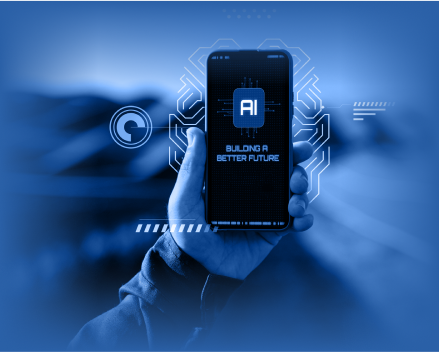
Ever wonder how your competitors are closing deals faster, reviewing contracts in minutes, and somehow staying on top of every regulatory update, without breaking a sweat?
Spoiler: they didn’t hire a hundred interns.
They built smarter tech.
We’re talking about Legal AI app development, where algorithms now do what paralegals used to lose weekends over.
If your law firm, startup, or SaaS platform isn’t exploring how to develop a legal AI application, you’re, honestly, not even on the graph yet.
And here's why that should keep you up tonight: the global legal AI market is projected to grow at a CAGR of 13.1% between 2025 and 2034.
The winners? Law firms and legal tech companies already moving fast to build AI apps for the legal industry, leaving the slow adopters tangled in paperwork and outdated systems.
This blog is your fast-track into that billion-dollar future.
We’ll walk you through everything from must-have features and advanced tech stacks to cost breakdowns, monetization strategies, and those “oh-no-you-didn’t” mistakes to avoid, whether you're exploring it yourself or working with an experienced AI app development company.
Whether you're ready to build a legal AI app, or just AI-curious (no judgment), you’re in the right place.
So buckle in, we’ll now be talking about what’s fueling this Legal AI gold rush, and why it might just be the smartest business move you make this year.
“Legal tech” used to mean fax machines that worked.
Today, it’s AI copilots scanning 300-page contracts before your coffee hits the sweet spot. If you’re still asking why you should build a legal AI app, you’re asking the wrong question. The real question is: how soon can you start?
Law firms, legal consultancies, SaaS startups, and corporate legal departments are racing to develop legal AI applications that reduce cost, speed up workflows, and (best of all) make them look like rockstars in front of clients.
Here’s what’s driving the demand:
| Legal Pain Point | How AI Solves It |
|---|---|
|
Contract review takes days |
NLP models review, flag, and summarize in minutes |
|
Legal research is labor-intensive |
Generative AI + legal databases = answers in seconds |
|
Compliance is hard to track |
AI tools monitor changes and alert teams instantly |
|
High overhead for repeat tasks |
Automation handles form generation, filing, client intake |
|
Case prediction is a guessing game |
Predictive analytics crunch precedent data and risk factors |
Legal AI apps aren’t theoretical anymore, they’re in courtrooms, conference rooms, and client portals right now.
Here’s a breakdown of the most impactful applications businesses are investing in as they build legal AI apps to gain serious operational advantage:
Managing contracts is like herding cats with legal consequences. AI-powered CLM systems take over the heavy lifting: from automated drafting and clause detection to redlining, approval workflows, and risk scoring.
It’s like having a super-analytical associate who never sleeps, misses a clause, or forgets version control.
Example: Tools like Juro and Luminance use NLP to surface hidden risks, compare similar clauses across documents, and accelerate negotiation cycles.
Ever wished you could peek into the future before filing a case? AI makes that possible.
By analyzing thousands of previous rulings, judge behaviors, legal arguments, and jurisdictional patterns, AI systems can estimate the likelihood of winning a case, or at least how much it’s going to cost you.
Example: Lex Machina and Premonition use predictive analytics to give legal teams insight into how likely a motion is to succeed before it’s even filed.
Think client intake, scheduling, Q&A, and initial legal advice handled instantly, without staff burnout.
Chatbots, powered by generative AI and legal knowledge bases, provide 24/7 support, while integrating with case management systems and CRM tools.
Example: DoNotPay’s AI chatbot can contest parking tickets, negotiate bills, or guide users through small claims court, all without human intervention.
If you’re considering building one for your firm, this guide on AI legal assistant development breaks down the process and cost.
Laws change. Frequently.
AI systems that monitor federal, state, and international regulations can alert your team the moment something shifts that affects your compliance status.
Whether you're navigating GDPR, HIPAA, or SEC updates, the right AI tool can automate alerts, generate compliance reports, and minimize risk exposure.
Example: Compliance.ai and Ascent use ML models to track, filter, and summarize regulatory changes across industries and jurisdictions.
In litigation and investigations, time is money, and traditional eDiscovery tools often burn both.
AI revolutionizes the process by scanning thousands (or millions) of documents, emails, chat logs, and PDFs to find relevant evidence using context-aware search, sentiment analysis, and entity recognition.
Example: Relativity Trace leverages AI to flag compliance breaches or internal risks by analyzing communication patterns in near real-time.
Instead of manually scrolling through endless statutes, case laws, or obscure legal opinions, AI can answer specific queries backed by citations.
Using retrieval-augmented generation (RAG), the AI pulls from relevant databases and presents grounded answers, something even senior associates struggle to do at speed.
Example: Casetext’s CoCounsel and Westlaw Edge offer natural language search and LLM-powered summarization to accelerate research workflows.
If you're planning to build an AI app for legal services, this is your moment. Clients expect instant answers. Teams need automated support. And frankly, nobody has time for 500-page PDFs anymore.
Next up, let’s break down what your AI-powered legal app needs to do, starting with the features that separate the rookies from the real players.
Building a legal AI app without the right features is like hiring a genius lawyer who refuses to pick up the phone or read contracts.
Functionality matters, and in this space, it can make or break your product’s credibility (and ROI).
Here’s a quick breakdown of the must-have features your app needs to earn its badge in the legal tech hall of fame:
| Feature | What It Does |
|---|---|
|
Natural Language Processing (NLP) |
Understands legal text, detects context, and enables smart search or summarization. |
|
Document Parsing & Analysis |
Converts PDFs, Word docs, and scanned legal files into structured, usable data. |
|
Contract Clause Detection |
Automatically identifies, highlights, and classifies critical contract elements. |
|
Legal Knowledge Base Integration |
Connects to legal libraries (e.g., Westlaw, LexisNexis) for verified source data. |
|
Secure Client Portal |
Lets users upload docs, view summaries, and communicate securely in one place. |
|
Version Control & Audit Trails |
Tracks edits and accesses for regulatory compliance and internal transparency. |
|
Search & Citation Generator |
Allows legal teams to query and cite statutes or precedents quickly. |
|
User Role Management |
Role-based access for clients, admins, and reviewers to preserve data control. |
|
API Integrations |
Seamlessly links with CLM systems, calendars, billing platforms, etc. |
|
Feedback & Correction Loop |
Allows users to flag issues, which the AI uses to improve performance. |
Role-based access for clients, admins, and reviewers to preserve data control and improve legal task delegation. Workflow automation plays a critical role in enabling such structured collaboration — here’s how legal workflow solutions are transforming legal operations.
Once your app nails the basics, it’s time to step into the big leagues.
These advanced capabilities are what attract power users, justify premium pricing, and unlock real-time efficiency gains for law firms and legal departments.
Forget generic responses.
RAG pipelines combine LLMs with vector search and legal data repositories to generate answers grounded in verified documents.
This helps mitigate hallucinations and supports AI decisions with evidence, something the legal industry insists on.
Using machine learning to spot patterns across case law, previous rulings, and judge behavior, your app can help legal teams predict case outcomes, win rates, or even risks in contract clauses.
It’s like giving your clients X-ray vision for litigation strategy.
AI models can assess risk levels in specific contract clauses and even recommend alternate phrasing or negotiation redlines.
This goes beyond detection.
It supports real-time decision-making for legal teams on the frontlines.
No legal professional wants a black-box AI. XAI ensures your app provides traceable reasoning, highlighting why a clause was flagged or a recommendation was made.
This increases trust and improves adoption, especially in compliance-heavy environments.
This feature continuously scans updates from regulatory bodies (SEC, GDPR regulators, etc.), maps changes to user-defined obligations, and notifies legal teams before they’re caught off-guard.
Think of it as a legal radar system that never blinks.
If you’re building for multinational firms or cross-border clients, multilingual NLP is key.
Advanced apps can translate, interpret, and analyze legal text in multiple jurisdictions without losing legal meaning—goodbye, Google Translate.
The takeaway? You can’t just slap a chatbot on a contract database and call it AI.
Whether you’re building for startups or large-scale enterprise use, these features form the foundation of trust, usability, and wow factor.
You’ve got the wishlist, now let’s turn it into a working legal AI app that actually delivers.
Contact NowUp next: Should you build it from scratch, buy an off-the-shelf solution, or blend both? Let’s break down your options like a seasoned in-house counsel.
There comes a point in every great idea’s life when someone asks: Should we build this ourselves… or just buy it?
And in the case of Legal AI app development, the answer isn’t always obvious.
Let’s break it down like a seasoned GC deciding how to modernize a legal department, with ROI in one hand and risk mitigation in the other.
Here’s a no-fluff comparison of all three approaches:
| Criteria | Build | Buy | Blend (Custom + Platform) |
|---|---|---|---|
|
Speed to Market |
Slow (3–9 months+) |
Fast (weeks) |
Medium (6–12 weeks depending on complexity) |
|
Upfront Cost |
High (dev team, infra, legal expertise) |
Moderate (license or subscription fee) |
Moderate to High (depends on integration scope) |
|
Long-term ROI |
High (custom IP, scalable) |
Moderate |
High (custom fit with platform efficiency) |
|
Customization |
Full control |
Minimal |
High (within platform limitations) |
|
Maintenance |
Your responsibility (ongoing costs) |
Vendor-managed |
Shared or hybrid |
|
Security & Compliance |
Fully owned & auditable |
Limited transparency |
Partially owned + platform compliance |
|
Integration Capability |
Fully flexible |
Limited to vendor’s API |
Selectively adaptable |
|
Best For |
Large firms, SaaS products, unique use-cases |
Solo firms, MVP testing, budget-conscious clients |
Mid-size firms, fast-moving startups, legal consultancies |
If you're an enterprise-level law firm or legal tech startup with specific goals, building from scratch offers the highest ceiling—but it comes at a cost (literally and figuratively).
Buying is ideal for firms that need something quick, simple, and off-the-shelf.
But the real MVP move? Blending.
A hybrid approach lets you customize what matters most, like AI workflows, dashboards, or compliance modules, while skipping the headache of building every brick from the ground up.
Think of it as leasing a Ferrari chassis and installing your own rocket engine.
And since you’re here, reading this blog with real intent (don’t think we didn’t notice), odds are your use case isn’t generic.
So yes, blend is your best bet.
Now, if you’re wondering how to actually develop that blended or built-from-scratch solution, don’t sweat it.
Up next, we’re walking you through the step-by-step process to bring your legal AI app to life.
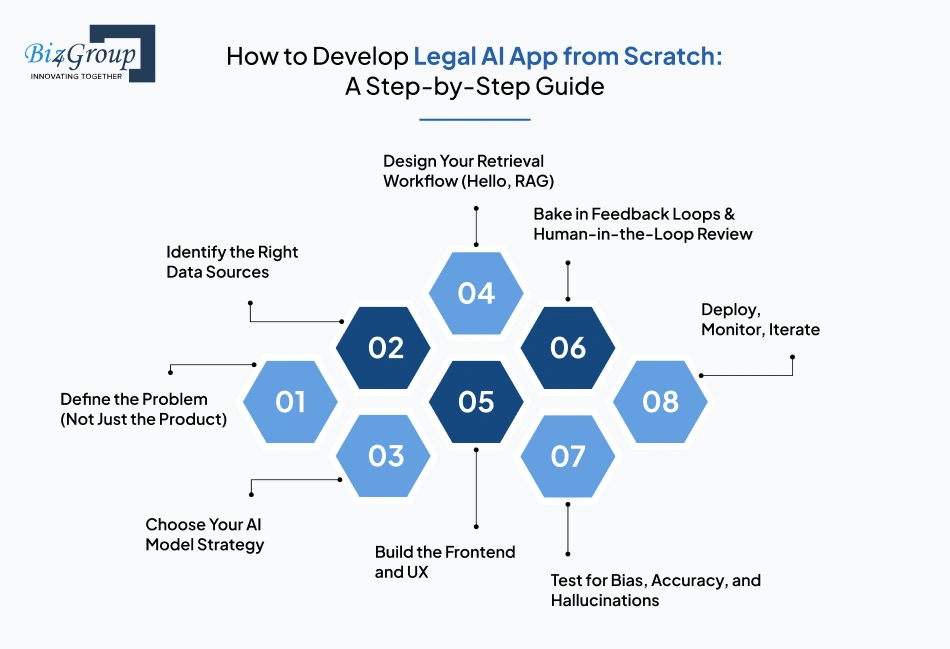
Building a legal AI app isn’t some mythical quest reserved for unicorn startups or VC-backed law firms. It’s a process, and like any good legal argument, it just needs to follow the right structure.
So, if you're thinking about how to develop a legal AI app from scratch, here’s the game plan:
You’re not “building an app”, you’re solving a problem.
Be crystal clear on what legal task you’re automating, simplifying, or supercharging.
Contract review? Litigation support? Compliance automation?
Pick your battlefield before bringing in the troops.
Bonus tip: Interview actual users—lawyers, paralegals, compliance officers.
What’s wasting their time? That’s your gold mine.
No data, no AI. Pull in:
Make sure your data is clean, structured, and legally safe to use.
Bias in, bias out and nobody wants an app that hallucinates during deposition prep.
You’ve got three options (and if you’re looking for a broader primer, here’s a great resource on how to build an AI app):
Whatever you choose, ensure it’s capable of interpreting legal language, not just general chit-chat.
Retrieval-Augmented Generation (RAG) is your secret weapon.
It grounds your model's answers in actual legal content so it doesn’t go rogue with made-up statutes.
Combine:
Because accuracy in legal apps is non-negotiable.
Even the smartest backend fails if the frontend feels like 2011. That’s why partnering with a UI/UX design company experienced in legal tech can be a game-changer.
Focus on:
Legal pros aren’t known for loving new tech, so make adoption frictionless.
Also read: The top UI/UX design companies in the USA
AI isn’t flawless, especially in high-stakes environments like law.
Build in mechanisms that:
The more your app learns from real users, the sharper it gets.
You’re dealing with legal outcomes, not Netflix recommendations.
Prioritize:
If your app confidently claims the Magna Carta was signed in 1987… back to the lab.
Launch a private beta with legal insiders, track usage, analyze feedback, and tweak ruthlessly.
Legal AI is not “set and forget”, it’s a living, learning system.
Building a legal AI app isn’t magic. It’s methodical.
But done right, it becomes a silent partner that delivers real value, at scale, without ever billing by the hour.
We’ve already briefed the whole case. Let’s get your legal AI app into production.
Schedule a Free CallNow that you’ve got the blueprint, let’s talk tools.
You can’t build a skyscraper with duct tape and dream boards.
Same goes for Legal AI apps.
If the foundation isn’t rock solid, the whole thing falls apart under real-world pressure (like handling a 300-page M&A contract on a Monday morning).
If you're planning to build a legal AI app that’s smart, secure, and scalable, including across devices with mobile application development, here’s the tech stack you’ll need to make it bulletproof.
| Purpose | Tech Stack Options |
|---|---|
|
Backend (Core Logic) |
Python (AI/ML), Node.js |
|
Frontend (UI/UX) |
React, Vue.js |
|
Web Frameworks |
Django, Flask, Express.js |
|
APIs/Integrations |
REST, GraphQL |
Python is your MVP here, thanks to its dominance in machine learning and natural language processing (NLP).
React is great for creating sleek, responsive UIs your users won’t run from.
| Function | Tools / Frameworks |
|---|---|
|
NLP & Legal Text Understanding |
spaCy, HuggingFace Transformers, LangChain |
|
LLM APIs |
OpenAI GPT-4, Anthropic Claude, Cohere |
|
Fine-tuned Legal Models |
LegalBERT, CaseLawBERT, LawGPT |
|
Prompt Management |
LangChain, LlamaIndex, PromptLayer |
Whether you're working with general LLMs or legal-specific ones, it’s smart to build a layer that manages prompts, context windows, and RAG pipelines efficiently.
| Function | Tools / Platforms |
|---|---|
|
Semantic Search & RAG |
Pinecone, Weaviate, Qdrant, FAISS |
|
Document Embedding |
OpenAI, Cohere, HuggingFace models |
These enable your app to actually answer legal questions with grounded context, not just generative fluff.
Your RAG system depends heavily on your choice of vector DB.
| Task | Tools |
|---|---|
|
PDF/Text Extraction |
PyMuPDF, PDFMiner, Apache Tika |
|
OCR (Scanned Docs) |
Tesseract, AWS Textract, Google Vision |
|
Structuring & Cleaning |
Pandas, spaCy pipelines |
Because legal data rarely shows up clean and pretty, and contracts love hiding secrets in footnotes and fine print.
| Area | Tools / Providers |
|---|---|
|
Cloud Infrastructure |
AWS, Azure, GCP |
|
Containerization |
Docker, Kubernetes |
|
Monitoring & Logging |
Prometheus, Grafana, ELK Stack |
|
CI/CD |
GitHub Actions, Jenkins, GitLab CI |
Legal AI apps must be stable, secure, and scale-ready from day one.
Kubernetes and containerization make your app adaptable across use cases and clients.
Pro tip: Don’t DIY everything.
Leverage proven platforms and focus your dev team on the features that differentiate your app, not the ones every SaaS company already solved five years ago.
So, you’ve got the tech, the talent, and the vision, but what’s it all going to cost? Let’s break down the numbers in plain English.
If there’s one thing lawyers don’t joke about, it’s compliance. (Okay, maybe that and billable hours.)
When it comes to legal AI app development for law firms, airtight security and regulatory alignment are super essential.
Remember: your app isn’t just managing any data. It’s handling confidential legal documents, privileged client communications, and case-sensitive information.
One breach or compliance misstep, and you’re suddenly the defendant.
Here’s how to keep your app out of hot water, and off the front page.
| Regulation | Applies To… | Your Responsibility |
|---|---|---|
|
GDPR (EU) |
EU citizens’ data |
Consent, data minimization, right to be forgotten |
|
CCPA/CPRA (California) |
California-based clients/users |
Data disclosures, opt-outs, access rights |
|
HIPAA (US) |
Legal-medical crossover use cases |
Protect health-related legal records |
|
ABA Model Rules |
U.S. legal professionals |
Confidentiality, secure tech usage |
|
SOC 2 Type II |
B2B SaaS, enterprise clients |
System integrity, privacy, and security controls |
If your app uses third-party APIs (e.g., GPT-4, LexisNexis), ensure:
Strong security builds user trust. Robust compliance builds institutional trust.
You’ll need both if you want to scale beyond MVP and land real law firm or enterprise clients.
Now, let’s get into the part everyone’s curious about (but no one wants to admit): how much does it actually cost to develop a legal AI app?
That’s what’s coming next. Let’s talk numbers.
So, how much does it actually cost to make an AI app for the legal industry?
On average, you're looking at anywhere between $30,000 and $250,000, depending on the complexity, features, and scale.
MVPs can launch lean and smart, but enterprise-grade solutions with predictive analytics, compliance automation, and RAG pipelines will push toward the higher end of that spectrum.
This question shows up in every discovery call, pitch deck, and Slack thread from Boston to Seattle. And while the answer is still “it depends,” it’s not just consultant-speak.
It depends on:
Let’s break it down in a way your CFO (and your tech lead) will both appreciate.
| App Tier | What’s Included | Estimated Cost (USD) |
|---|---|---|
|
Basic MVP |
Legal chatbot, basic document upload, simple AI-powered Q&A |
$25,000 – $50,000 |
|
Mid-Level App |
NLP, contract parsing, clause detection, user roles, API integrations |
$50,000 – $100,000 |
|
Enterprise-Grade |
RAG pipeline, predictive analytics, XAI, SOC 2 readiness, custom dashboards |
$120,000 – $250,000+ |
Note: These are ballpark ranges. Prices vary based on the feature set, team expertise, and compliance overhead.
| Phase | Scope | Approx. Cost |
|---|---|---|
|
Discovery & Planning |
Use case definition, data mapping, compliance scoping |
$5,000 – $15,000 |
|
Design & Prototyping |
Wireframes, UX flows, user journey mapping |
$8,000 – $20,000 |
|
Development (Core) |
Backend, AI/ML pipeline, database, RAG setup |
$30,000 – $80,000 |
|
Testing & QA |
Functional testing, red-teaming for hallucinations, user feedback |
$5,000 – $15,000 |
|
Deployment & Support |
Cloud infra, monitoring, support tools |
$5,000 – $10,000+ monthly |
These are the ones that are often forgotten until they show up on an invoice:
TL;DR? You don’t need VC money to start, but you do need clarity on what you’re building.
A basic legal AI assistant can be launched lean, but advanced apps, especially those integrating RAG, analytics, and enterprise compliance, require serious investment.
We build legal tech that saves money, not swallows budgets. Let’s make your CFO smile.
Build with UsNext, we’ll talk about how you can optimize these costs and even monetize your app.
Let’s talk strategy.
You’ve built it or you’re about to. Now what?
It’s time to make sure your legal AI app doesn’t just exist... it thrives.
Whether your goal is internal efficiency, user growth, or recurring revenue, optimizing your app’s performance and monetizing its potential is how you go from cool tech to a serious business asset.
Building a smart app is great.
But building one that’s fast, scalable, and doesn't rack up surprise AWS bills? That’s where the real magic happens.
Also read: The top MVP development companies in the USA
Efficiency is about sharpening edges.
The more strategic you are now, the more room you’ll have later to grow, scale, and monetize.
Speaking of which... let’s talk about turning your brilliant AI tool into a revenue-generating machine.
You’ve built the app. It works. It wows.
Now it’s time to make it pay rent, and ideally, a beachfront mortgage.
Here’s how to turn your AI legal app development into recurring, scalable revenue.
The classic model, and still a favorite for good reason.
Offer monthly or annual plans based on:
Why it works:
Predictable revenue, tiered upsell potential, and mass-market appeal.
Perfect for law firms, in-house counsel, and LPOs.
Every time a user uploads a contract, asks a legal question, or generates a compliance report, they pay a micro-fee.
Great for apps that provide high-value outputs (e.g., clause risk scoring or document generation).
Why it works:
Scales effortlessly with usage and aligns perfectly with value delivered.
Also ideal for partners who want to integrate your AI into their workflows.
Let consultancies, legal tech platforms, or LPOs slap their brand on your AI engine and resell it to their own clients.
You stay behind the curtain, and they become the face.
You both get paid.
Why it works:
Low customer acquisition cost, high ROI, and enterprise-ready revenue without doubling your sales team.
Give users a taste with basic functionality (e.g., document upload and summary) and charge for the advanced stuff, like predictive litigation analytics, clause negotiation tools, or regulatory alerting engines.
Why it works: Reduces friction at signup, builds a user base fast, and creates a natural upsell path, especially for on-demand app development models targeting self-serve legal services.
For big firms and corporate legal teams, offer customized builds.
Tailor workflows, plug into their tech stack, offer enhanced data isolation, and deliver true enterprise AI solutions built for legal operations at scale.
Why it works: High-margin deals, deeper client relationships, and recurring services revenue (support, updates, integrations).
Beyond document review and compliance, AI is also transforming how attorneys manage billing and time tracking. If you’re exploring this niche, this guide on building AI-powered attorney billing software breaks down the development process, features, and pricing strategies.
Each of these models can work on its own, or as part of a tiered monetization plan.
Want recurring revenue and big enterprise deals? Do both.
Want to attract solo lawyers and resellers? Freemium plus white-label licensing is your friend.
But here’s the real win: design your monetization strategy around value, not features.
Solve meaningful problems.
Deliver measurable ROI.
And price accordingly.
Next up is the part no one puts on pitch decks—challenges, faceplants, and costly mistakes in legal AI app development.
Let’s unpack them so you don’t make them.
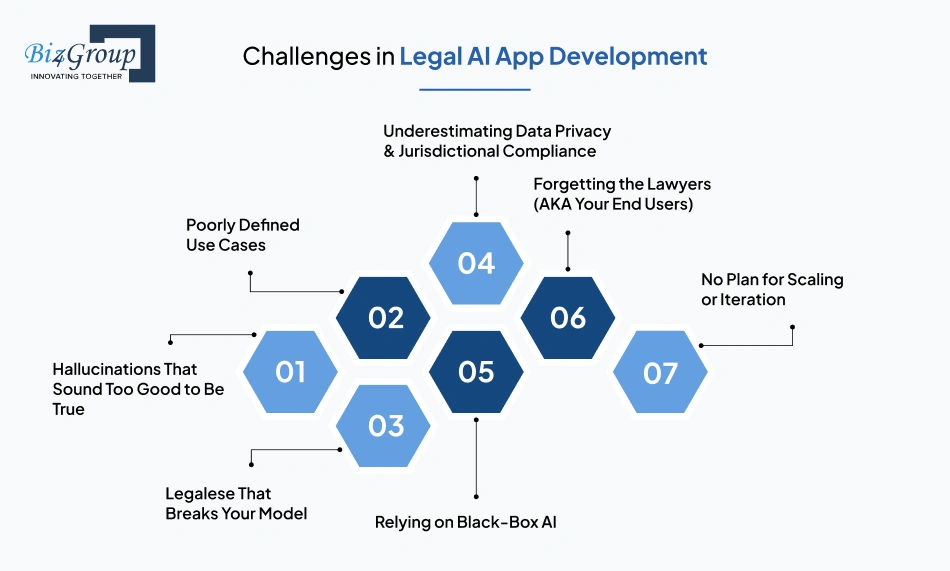
Building a legal AI app sounds like a cutting-edge tech play, and it is.
But it’s also a legal minefield, a product-market tightrope, and a development marathon wrapped in compliance red tape.
Let’s make sure your journey doesn’t turn into a cautionary tale.
Here are the top challenges we see during the development of legal AI apps, and how to dodge them like a seasoned in-house counsel with a deadline and no coffee.
AI sometimes… lies. Confidently.
And in legal settings, a fabricated statute or imaginary precedent? Forget embarrassing, it’s downright dangerous.
Fix it with:
Trying to do everything at once? You’ll end up with an app that does nothing well, and integrating the wrong tools at the wrong time can make it worse. Strategic planning and expert AI integration services can ensure everything fits together from day one.
Narrow your focus: are you solving contract review? Compliance monitoring? Client intake?
Fix it with:
Legal text is formal, specific, and context-sensitive.
A general-purpose LLM might handle casual Q&A well but completely miss the nuance in a double indemnity clause.
Fix it with:
That NDA might look harmless until you realize you’re storing EU client data in a non-GDPR-compliant cloud.
Regulatory mistakes here are expensive, legally and reputationally.
Fix it with:
In law, “because the model said so” is not a valid justification.
Lack of explainability leads to user mistrust, and potential ethical violations.
Fix it with:
What looks slick to a dev team might be confusing, overwhelming, or downright irritating to legal professionals.
If it’s not intuitive, it won’t get used.
Fix it with:
AI apps aren’t static products. They evolve.
If you didn’t architect for scalability, your app might buckle when success hits.
Fix it with:
Building an AI app for legal services means playing in a high-stakes arena, but that’s also where the biggest wins happen.
And now that you know what to look out for, you’re already ahead of 80% of teams.
We’ve dodged every trap so you don’t have to. Partner with pros who’ve done it before.
Talk to Our ExpertsNow, let’s see what’s next in this fast-moving space, and what your app needs to be ready for.
What’s next for legal AI?
More buzzwords? More hallucinating chatbots? Hopefully not.
The truth is, the future of building AI apps for legal services isn’t about replacing lawyers. It’s about augmenting them.
Think of it as Iron Man’s suit for legal teams: they still drive, but now they fly.
Here are the trends that will shape the next generation of legal AI applications:
Expect a shift from passive tools to active, AI-powered legal copilots, an area where a skilled AI agent development company can give your product a serious edge.
Instead of just summarizing a contract, your app will suggest revisions, highlight liabilities, and maybe even send the follow-up email (with proper legal tone, of course).
As regulations tighten (hello, EU AI Act), and clients demand transparency, apps will need built-in reasoning layers.
“Why did the model flag this clause?” should have a clear, traceable answer.
No black-box mysteries allowed.
Legal teams working across borders are demanding tools that understand not just multiple languages, but also local laws and nuances.
Future apps will be smart enough to translate and interpret with legal accuracy, not just linguistic one.
More firms will ditch public APIs in favor of self-hosted or fine-tuned private LLMs.
This helps protect client confidentiality and reduces vendor risk, especially for enterprise clients with sensitive case data.
Think legal Siri, but smarter.
Future apps may integrate voice-based command systems where lawyers can dictate briefs, draft responses, or initiate compliance reports on the go.
Less typing, more lawyering.
With global regulations evolving faster than your favorite series finale, apps will integrate real-time compliance alert engines, syncing directly with government portals and pushing updates to in-house teams or clients.
As AI plays a bigger role in legal strategy, governance will become a feature, not a footnote. Expect tools that document AI decision trails, capture model updates, and ensure compliance with internal policies or legal ethics boards.
In short, the future is more intelligent, more transparent, and more lawyer-friendly than ever.
And the best time to start building for that future? Yesterday.
The second-best time? Right after you finish this blog.
Now, let’s talk about why we might just be your perfect development partner.
Developing a high-stakes, high-impact legal AI app isn’t something you want to leave to an “AI enthusiast” with a Github repo and Wi-Fi issues.
You need a team that knows what’s at stake.
One that combines deep technical expertise, real product thinking, and an understanding of the legal landscape, like a proven AI development company with domain experience.
You need Biz4Group, your trusted advisors in navigating the fast-evolving world of legal AI app development.
We’re a US-based software development company that specializes in building cutting-edge AI applications for entrepreneurs, enterprises, and forward-thinking firms. We build apps and we do it right.
Doubting if this is too good to be true? Here you go...
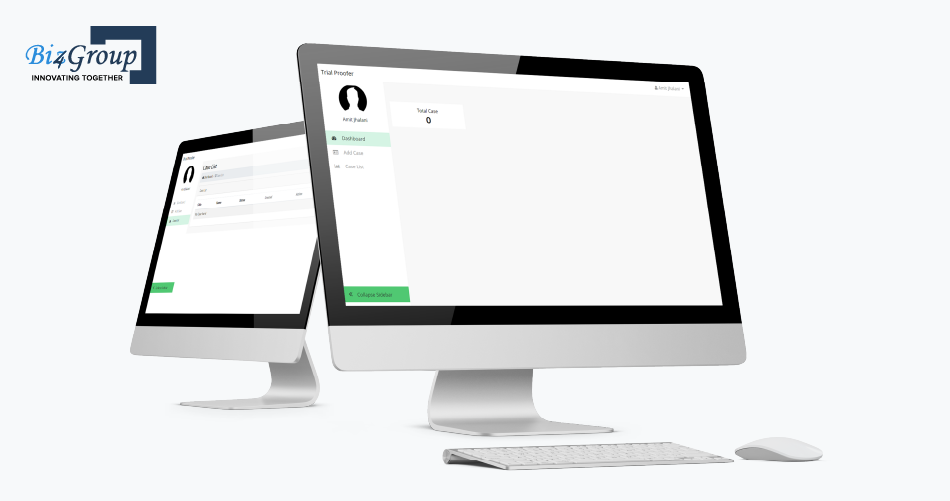
When our client approached us with the idea of a modern, client-facing legal automation platform, Trial Proofer, they weren’t asking for just another document dashboard. They wanted to reimagine what a law firm could be—virtual, smart, and as precise as any courtroom filing.
But here’s the catch: legal operations don’t leave much room for error. Our challenge was to simplify complex workflows, enable seamless digital collaboration, and integrate legal intelligence into a platform that attorneys and clients alike could rely on.
The legal industry is detail-obsessed for good reason. But that level of complexity makes digitization tricky.
Our biggest hurdle? Designing a system that could automate and simplify the entire legal service journey, from discovery to cross-examination, without losing the nuance legal work demands.
We also had to ensure:
Trial Proofer became a secure, intelligent, and intuitive legal operations platform built for the hybrid law firm era.
Key Features Built by Biz4Group:
Instead of building a bulky case management system, we engineered a logic-driven framework that mirrors how legal professionals actually think.
Every tab, tool, and integration was carefully crafted to enhance, not interrupt, the legal workflow.
We used:
Trial Proofer now empowers law firms to operate with the efficiency of SaaS and the integrity of traditional practice, remotely, reliably, and intelligently.
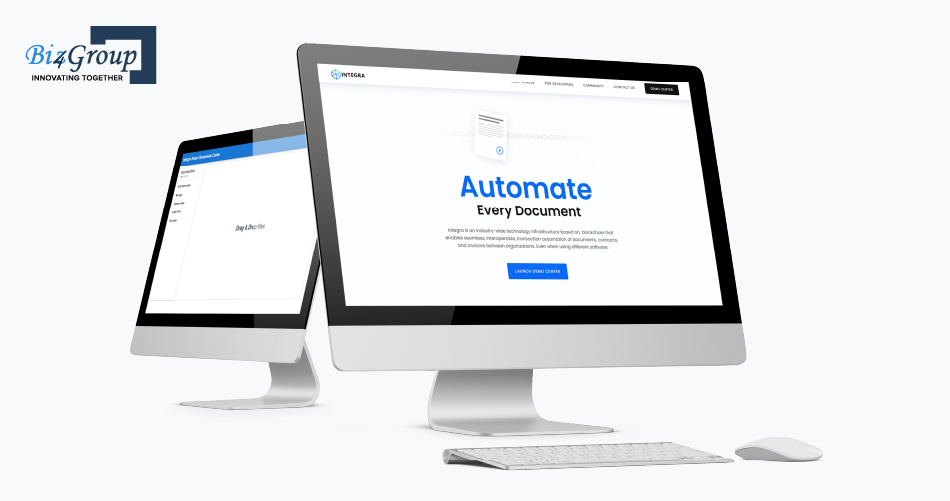
When you think of blockchain, your mind might jump to crypto wallets and NFTs.
But one of its most underrated, and potentially industry-transforming, applications lies in legal documentation and enterprise contracts.
That’s exactly where Integra Ledger set its sights, and Biz4Group was brought in to bring the vision to life.
This wasn’t just about adding a blockchain label to a legal tech tool. It was about reengineering how legal documents are created, shared, and secured, across enterprises, jurisdictions, and industries.
Our client needed more than a platform.
They needed an entire blockchain-based infrastructure for the legal industry, capable of:
Oh, and it had to support enterprise-level scalability, user customization, and branding, without compromising security.
With Integra Ledger, we built a blockchain-powered legal tech platform that allows organizations to securely automate, demo, and distribute legal documents and smart contracts, with full interoperability.
Key Features Engineered by Biz4Group:
We approached this with a focus on trust, traceability, and real-world usability.
Integra Ledger now serves as a cornerstone in legal blockchain innovation, helping organizations elevate trust, reduce document risk, and showcase their capabilities with confidence.
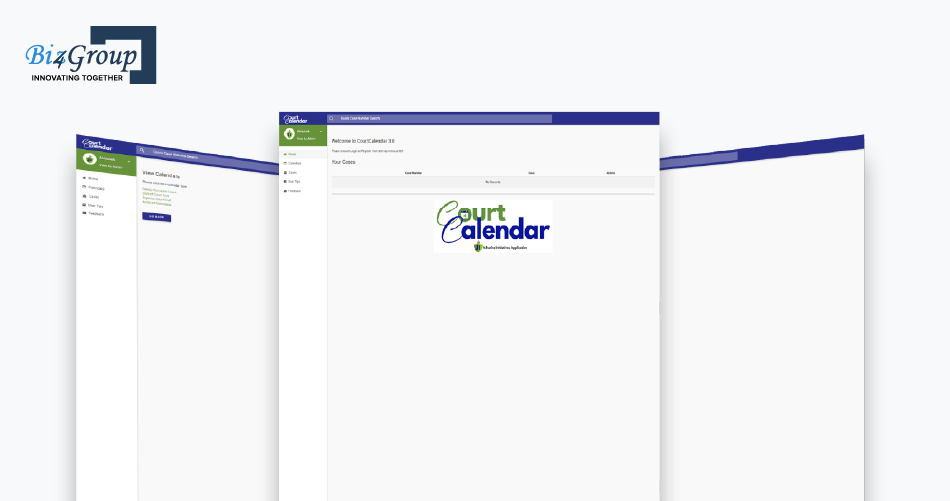
Courtroom chaos is a real operational challenge. As case backlogs grow and court schedules overflow, attorneys are left juggling documents, deadlines, and delays.
That’s where Court Calendar comes in, a judiciary platform built to bring order to the legal scheduling madness.
In partnership with Biz4Group, leading law firms in the U.S. set out to create a solution that simplifies how attorneys manage their court appearances and related administrative work.
The U.S. legal system is strained under the weight of thousands of active and pending cases. Even with expanded hours and added personnel, bottlenecks continue.
What attorneys needed was a tool that could:
And it needed to be secure, scalable, and simple enough for busy attorneys to adopt without a steep learning curve.
We developed a purpose-built judiciary platform that helps attorneys and surrogates manage court calendars, communicate with colleagues, and stay ahead of crucial hearing dates, all in one place.
Core Features Developed by Biz4Group:
This wasn’t just another case tracker. We built a legal ecosystem, engineered to:
We focused on:
Now, attorneys can get onboard quickly, stay informed on case statuses, and schedule hearings without drowning in paperwork.
And courts? They benefit too, with a smoother, more connected system that promotes judicial efficiency.
Basically, what we are trying to say is... whether you're building a virtual law firm from scratch, automating compliance workflows, or making case scheduling less of a nightmare, we’ve done it, and we’ve done it well.
From blockchain-backed integrity to AI-powered insights, our portfolio doesn’t just show we can build legal tech. It proves we know how to make it usable, scalable, and actually... liked by lawyers. (Yes, that’s a thing.)
So if you're serious about legal AI app development, skip the fluff, sidestep the guesswork, and let’s build something that’s both legally sound and technically elite.
Let’s talk.
Legal tech isn’t the future. It’s the now.
And if you’re still debating whether to get on board with legal AI app development, consider this: your competitors already are, and they’re probably working with an experienced AI development company to move faster.
From smarter case prep to automated compliance and AI-assisted document review, the legal industry is embracing innovation not because it’s trendy, but because it works.
And it’s changing the way law firms, legal departments, and tech-first startups deliver value.
But building a legal AI app isn’t just about code and features.
It’s about getting the right partner. A team that understands legal workflows, regulatory risks, and the technologies that make real impact.
That’s where Biz4Group comes in.
We’re not just developers; we’re your trusted advisors in building legal AI solutions that are scalable, secure, and built to perform.
So whether you’re ready to build or still mapping out your next move, start smart. Or better yet, hire AI developers who’ve done it before.
Start with Biz4Group.
Not necessarily. While proprietary legal data can enhance accuracy, many apps are built using public legal datasets or external APIs from established legal data providers. The key is designing your app to either integrate with those sources or support secure, compliant ingestion of your own firm’s data.
You’ll need to implement clear disclaimers, user-level controls, and boundary rules within your AI logic. Also, avoid automated conclusions or actions that mimic human legal advice, especially in regulated jurisdictions. Having a human-in-the-loop system helps mitigate these risks.
Legal AI involves machine learning, NLP, and intelligent analysis, like summarizing contracts or predicting outcomes. Legal automation, on the other hand, focuses on rule-based workflows, like sending alerts, routing documents, or filling forms. Many effective apps blend both.
It depends on complexity, but a basic MVP can take 8–12 weeks. More advanced apps with AI-driven features, integrations, and compliance mechanisms can take 4–6 months or more. The timeline also varies based on testing, training, and regulatory validation cycles.
No, but they’ll change how lawyers work. AI can handle repetitive, time-consuming tasks like legal research or document review, but it can’t replicate strategic thinking, negotiation skills, or nuanced judgment. Think of it as augmentation, not replacement.
with Biz4Group today!
Our website require some cookies to function properly. Read our privacy policy to know more.